Business Finance: Financial Statement Review and Performance Analysis
VerifiedAdded on 2023/06/18
|11
|2755
|68
Report
AI Summary
This report provides a comprehensive analysis of business finance, focusing on the importance of financial management, key financial statements, and the use of ratios for performance evaluation. It delves into the role of financial planning, fund allocation, company valuation, and investment opportunities in achieving business goals. The report explains the significance of income statements, balance sheets, and cash flow statements in understanding a company's financial position. It further examines profitability, liquidity, and solvency ratios to assess business performance, highlighting strategies for improvement through marketing and financial tactics. The analysis includes a review of business performance using various financial metrics, demonstrating how companies can enhance their profitability and efficiency. This detailed overview is designed to provide a thorough understanding of financial management principles and their practical application in improving business outcomes. Desklib offers a wide range of solved assignments and study tools to assist students in mastering these concepts.

BUSINESS FINANCE
Paraphrase This Document
Need a fresh take? Get an instant paraphrase of this document with our AI Paraphraser
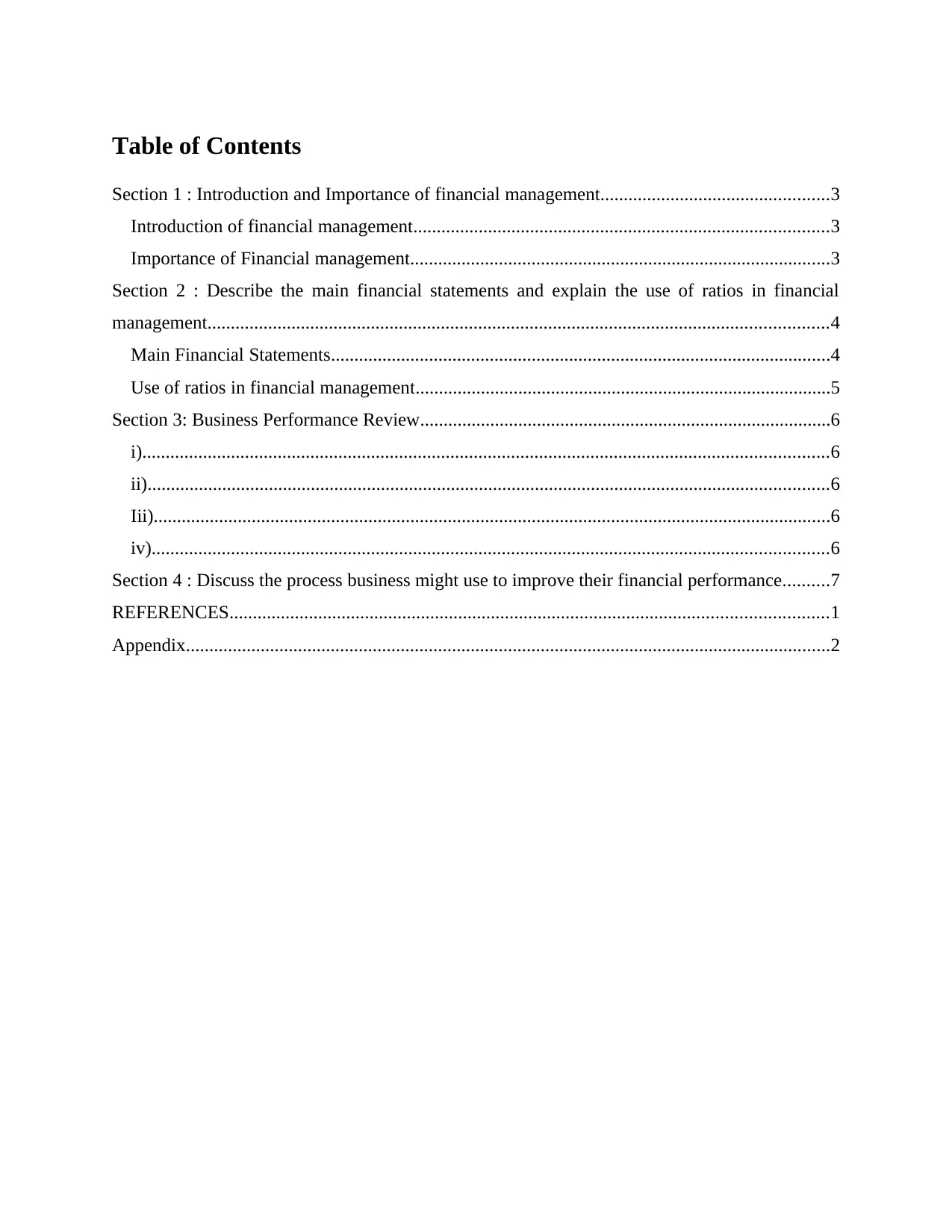
Table of Contents
Section 1 : Introduction and Importance of financial management.................................................3
Introduction of financial management.........................................................................................3
Importance of Financial management..........................................................................................3
Section 2 : Describe the main financial statements and explain the use of ratios in financial
management.....................................................................................................................................4
Main Financial Statements...........................................................................................................4
Use of ratios in financial management.........................................................................................5
Section 3: Business Performance Review........................................................................................6
i)...................................................................................................................................................6
ii)..................................................................................................................................................6
Iii).................................................................................................................................................6
iv).................................................................................................................................................6
Section 4 : Discuss the process business might use to improve their financial performance..........7
REFERENCES................................................................................................................................1
Appendix..........................................................................................................................................2
Section 1 : Introduction and Importance of financial management.................................................3
Introduction of financial management.........................................................................................3
Importance of Financial management..........................................................................................3
Section 2 : Describe the main financial statements and explain the use of ratios in financial
management.....................................................................................................................................4
Main Financial Statements...........................................................................................................4
Use of ratios in financial management.........................................................................................5
Section 3: Business Performance Review........................................................................................6
i)...................................................................................................................................................6
ii)..................................................................................................................................................6
Iii).................................................................................................................................................6
iv).................................................................................................................................................6
Section 4 : Discuss the process business might use to improve their financial performance..........7
REFERENCES................................................................................................................................1
Appendix..........................................................................................................................................2
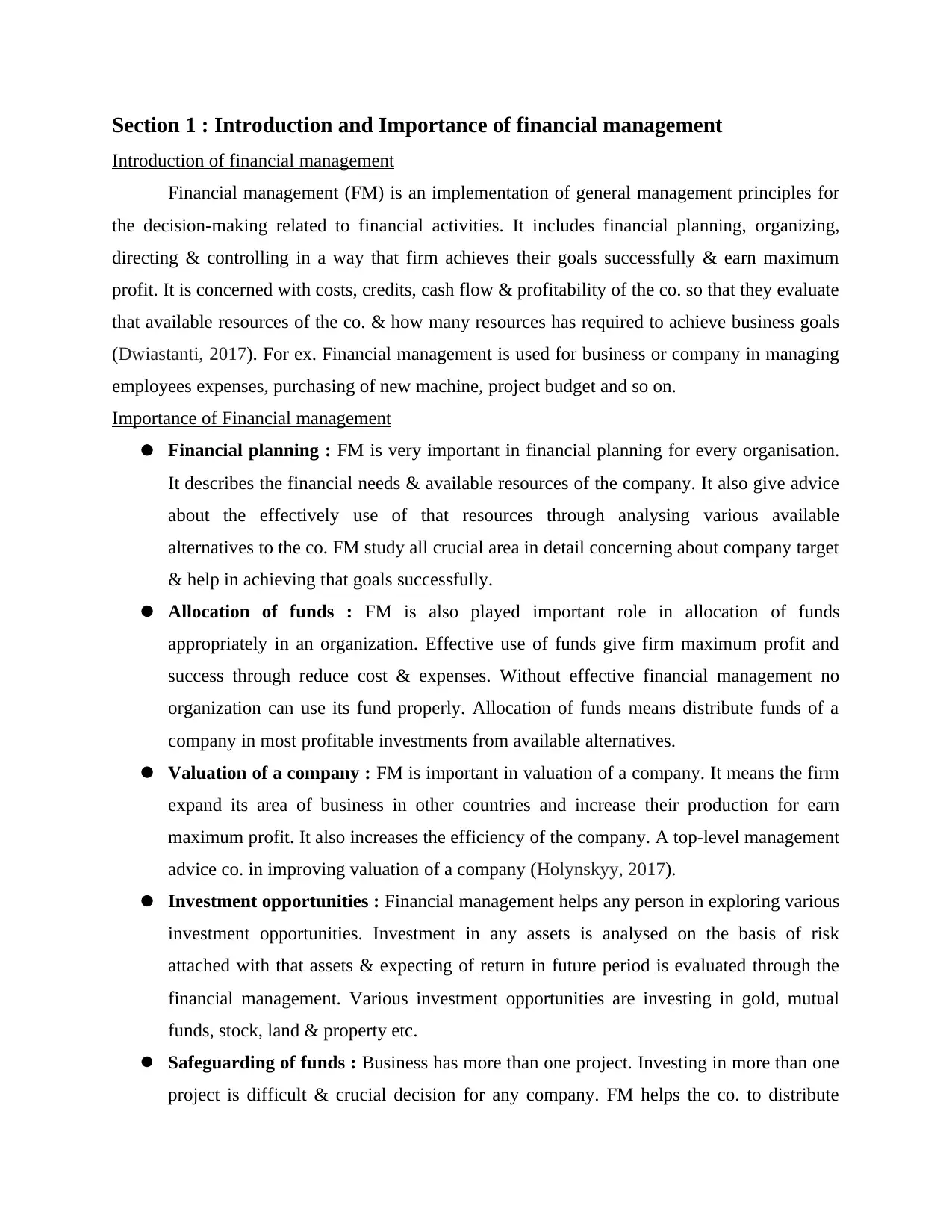
Section 1 : Introduction and Importance of financial management
Introduction of financial management
Financial management (FM) is an implementation of general management principles for
the decision-making related to financial activities. It includes financial planning, organizing,
directing & controlling in a way that firm achieves their goals successfully & earn maximum
profit. It is concerned with costs, credits, cash flow & profitability of the co. so that they evaluate
that available resources of the co. & how many resources has required to achieve business goals
(Dwiastanti, 2017). For ex. Financial management is used for business or company in managing
employees expenses, purchasing of new machine, project budget and so on.
Importance of Financial management
Financial planning : FM is very important in financial planning for every organisation.
It describes the financial needs & available resources of the company. It also give advice
about the effectively use of that resources through analysing various available
alternatives to the co. FM study all crucial area in detail concerning about company target
& help in achieving that goals successfully.
Allocation of funds : FM is also played important role in allocation of funds
appropriately in an organization. Effective use of funds give firm maximum profit and
success through reduce cost & expenses. Without effective financial management no
organization can use its fund properly. Allocation of funds means distribute funds of a
company in most profitable investments from available alternatives.
Valuation of a company : FM is important in valuation of a company. It means the firm
expand its area of business in other countries and increase their production for earn
maximum profit. It also increases the efficiency of the company. A top-level management
advice co. in improving valuation of a company (Holynskyy, 2017).
Investment opportunities : Financial management helps any person in exploring various
investment opportunities. Investment in any assets is analysed on the basis of risk
attached with that assets & expecting of return in future period is evaluated through the
financial management. Various investment opportunities are investing in gold, mutual
funds, stock, land & property etc.
Safeguarding of funds : Business has more than one project. Investing in more than one
project is difficult & crucial decision for any company. FM helps the co. to distribute
Introduction of financial management
Financial management (FM) is an implementation of general management principles for
the decision-making related to financial activities. It includes financial planning, organizing,
directing & controlling in a way that firm achieves their goals successfully & earn maximum
profit. It is concerned with costs, credits, cash flow & profitability of the co. so that they evaluate
that available resources of the co. & how many resources has required to achieve business goals
(Dwiastanti, 2017). For ex. Financial management is used for business or company in managing
employees expenses, purchasing of new machine, project budget and so on.
Importance of Financial management
Financial planning : FM is very important in financial planning for every organisation.
It describes the financial needs & available resources of the company. It also give advice
about the effectively use of that resources through analysing various available
alternatives to the co. FM study all crucial area in detail concerning about company target
& help in achieving that goals successfully.
Allocation of funds : FM is also played important role in allocation of funds
appropriately in an organization. Effective use of funds give firm maximum profit and
success through reduce cost & expenses. Without effective financial management no
organization can use its fund properly. Allocation of funds means distribute funds of a
company in most profitable investments from available alternatives.
Valuation of a company : FM is important in valuation of a company. It means the firm
expand its area of business in other countries and increase their production for earn
maximum profit. It also increases the efficiency of the company. A top-level management
advice co. in improving valuation of a company (Holynskyy, 2017).
Investment opportunities : Financial management helps any person in exploring various
investment opportunities. Investment in any assets is analysed on the basis of risk
attached with that assets & expecting of return in future period is evaluated through the
financial management. Various investment opportunities are investing in gold, mutual
funds, stock, land & property etc.
Safeguarding of funds : Business has more than one project. Investing in more than one
project is difficult & crucial decision for any company. FM helps the co. to distribute
⊘ This is a preview!⊘
Do you want full access?
Subscribe today to unlock all pages.

Trusted by 1+ million students worldwide
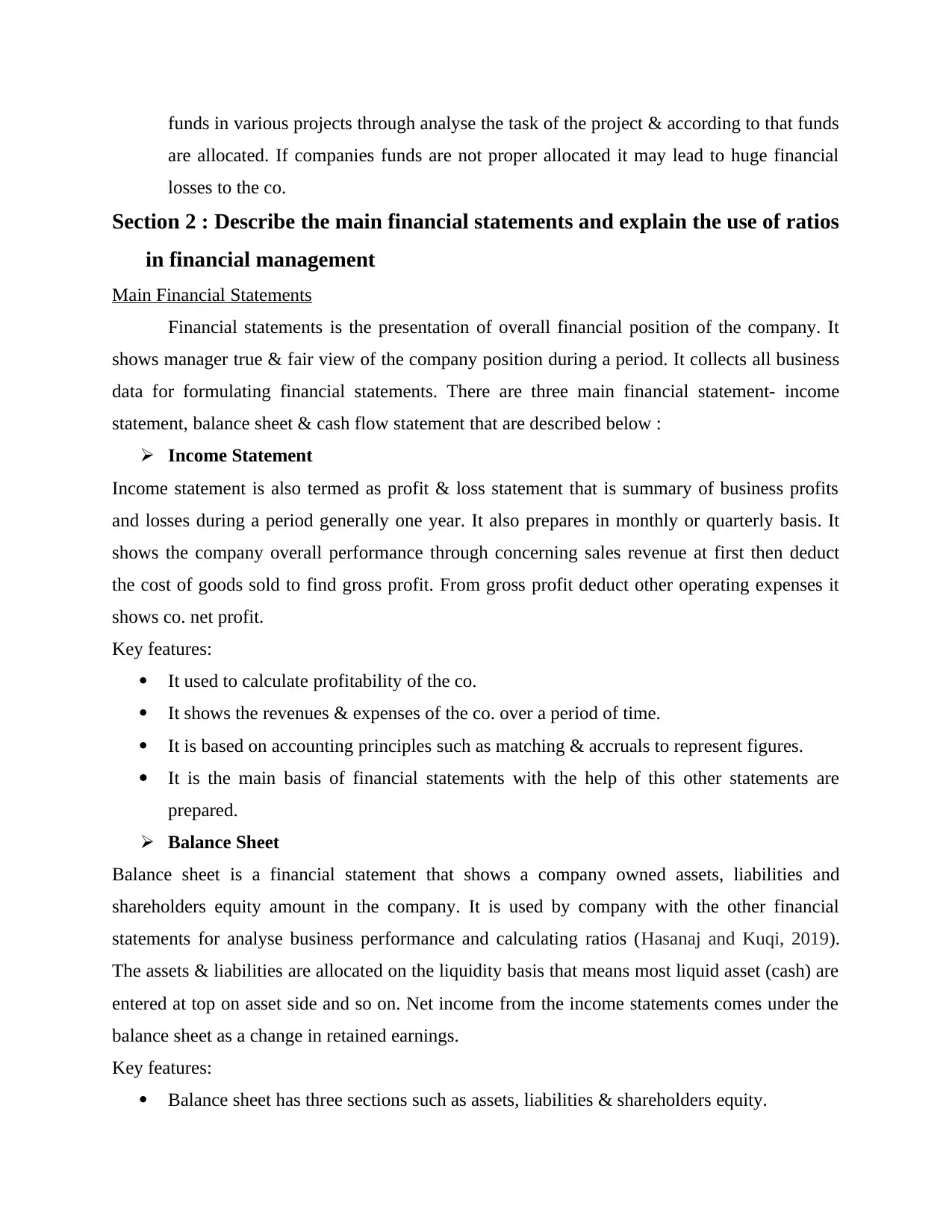
funds in various projects through analyse the task of the project & according to that funds
are allocated. If companies funds are not proper allocated it may lead to huge financial
losses to the co.
Section 2 : Describe the main financial statements and explain the use of ratios
in financial management
Main Financial Statements
Financial statements is the presentation of overall financial position of the company. It
shows manager true & fair view of the company position during a period. It collects all business
data for formulating financial statements. There are three main financial statement- income
statement, balance sheet & cash flow statement that are described below :
Income Statement
Income statement is also termed as profit & loss statement that is summary of business profits
and losses during a period generally one year. It also prepares in monthly or quarterly basis. It
shows the company overall performance through concerning sales revenue at first then deduct
the cost of goods sold to find gross profit. From gross profit deduct other operating expenses it
shows co. net profit.
Key features:
It used to calculate profitability of the co.
It shows the revenues & expenses of the co. over a period of time.
It is based on accounting principles such as matching & accruals to represent figures.
It is the main basis of financial statements with the help of this other statements are
prepared.
Balance Sheet
Balance sheet is a financial statement that shows a company owned assets, liabilities and
shareholders equity amount in the company. It is used by company with the other financial
statements for analyse business performance and calculating ratios (Hasanaj and Kuqi, 2019).
The assets & liabilities are allocated on the liquidity basis that means most liquid asset (cash) are
entered at top on asset side and so on. Net income from the income statements comes under the
balance sheet as a change in retained earnings.
Key features:
Balance sheet has three sections such as assets, liabilities & shareholders equity.
are allocated. If companies funds are not proper allocated it may lead to huge financial
losses to the co.
Section 2 : Describe the main financial statements and explain the use of ratios
in financial management
Main Financial Statements
Financial statements is the presentation of overall financial position of the company. It
shows manager true & fair view of the company position during a period. It collects all business
data for formulating financial statements. There are three main financial statement- income
statement, balance sheet & cash flow statement that are described below :
Income Statement
Income statement is also termed as profit & loss statement that is summary of business profits
and losses during a period generally one year. It also prepares in monthly or quarterly basis. It
shows the company overall performance through concerning sales revenue at first then deduct
the cost of goods sold to find gross profit. From gross profit deduct other operating expenses it
shows co. net profit.
Key features:
It used to calculate profitability of the co.
It shows the revenues & expenses of the co. over a period of time.
It is based on accounting principles such as matching & accruals to represent figures.
It is the main basis of financial statements with the help of this other statements are
prepared.
Balance Sheet
Balance sheet is a financial statement that shows a company owned assets, liabilities and
shareholders equity amount in the company. It is used by company with the other financial
statements for analyse business performance and calculating ratios (Hasanaj and Kuqi, 2019).
The assets & liabilities are allocated on the liquidity basis that means most liquid asset (cash) are
entered at top on asset side and so on. Net income from the income statements comes under the
balance sheet as a change in retained earnings.
Key features:
Balance sheet has three sections such as assets, liabilities & shareholders equity.
Paraphrase This Document
Need a fresh take? Get an instant paraphrase of this document with our AI Paraphraser
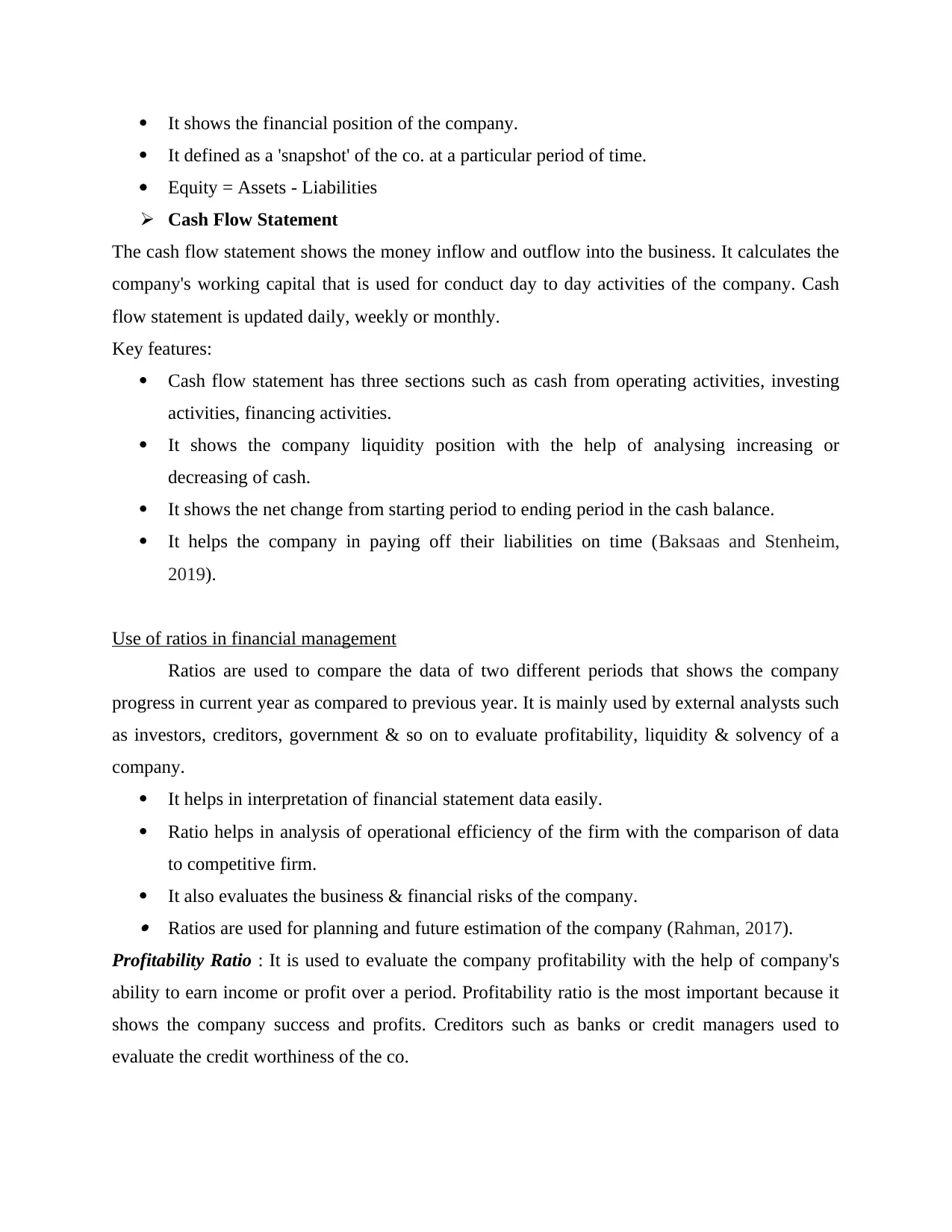
It shows the financial position of the company.
It defined as a 'snapshot' of the co. at a particular period of time.
Equity = Assets - Liabilities
Cash Flow Statement
The cash flow statement shows the money inflow and outflow into the business. It calculates the
company's working capital that is used for conduct day to day activities of the company. Cash
flow statement is updated daily, weekly or monthly.
Key features:
Cash flow statement has three sections such as cash from operating activities, investing
activities, financing activities.
It shows the company liquidity position with the help of analysing increasing or
decreasing of cash.
It shows the net change from starting period to ending period in the cash balance.
It helps the company in paying off their liabilities on time (Baksaas and Stenheim,
2019).
Use of ratios in financial management
Ratios are used to compare the data of two different periods that shows the company
progress in current year as compared to previous year. It is mainly used by external analysts such
as investors, creditors, government & so on to evaluate profitability, liquidity & solvency of a
company.
It helps in interpretation of financial statement data easily.
Ratio helps in analysis of operational efficiency of the firm with the comparison of data
to competitive firm.
It also evaluates the business & financial risks of the company. Ratios are used for planning and future estimation of the company (Rahman, 2017).
Profitability Ratio : It is used to evaluate the company profitability with the help of company's
ability to earn income or profit over a period. Profitability ratio is the most important because it
shows the company success and profits. Creditors such as banks or credit managers used to
evaluate the credit worthiness of the co.
It defined as a 'snapshot' of the co. at a particular period of time.
Equity = Assets - Liabilities
Cash Flow Statement
The cash flow statement shows the money inflow and outflow into the business. It calculates the
company's working capital that is used for conduct day to day activities of the company. Cash
flow statement is updated daily, weekly or monthly.
Key features:
Cash flow statement has three sections such as cash from operating activities, investing
activities, financing activities.
It shows the company liquidity position with the help of analysing increasing or
decreasing of cash.
It shows the net change from starting period to ending period in the cash balance.
It helps the company in paying off their liabilities on time (Baksaas and Stenheim,
2019).
Use of ratios in financial management
Ratios are used to compare the data of two different periods that shows the company
progress in current year as compared to previous year. It is mainly used by external analysts such
as investors, creditors, government & so on to evaluate profitability, liquidity & solvency of a
company.
It helps in interpretation of financial statement data easily.
Ratio helps in analysis of operational efficiency of the firm with the comparison of data
to competitive firm.
It also evaluates the business & financial risks of the company. Ratios are used for planning and future estimation of the company (Rahman, 2017).
Profitability Ratio : It is used to evaluate the company profitability with the help of company's
ability to earn income or profit over a period. Profitability ratio is the most important because it
shows the company success and profits. Creditors such as banks or credit managers used to
evaluate the credit worthiness of the co.
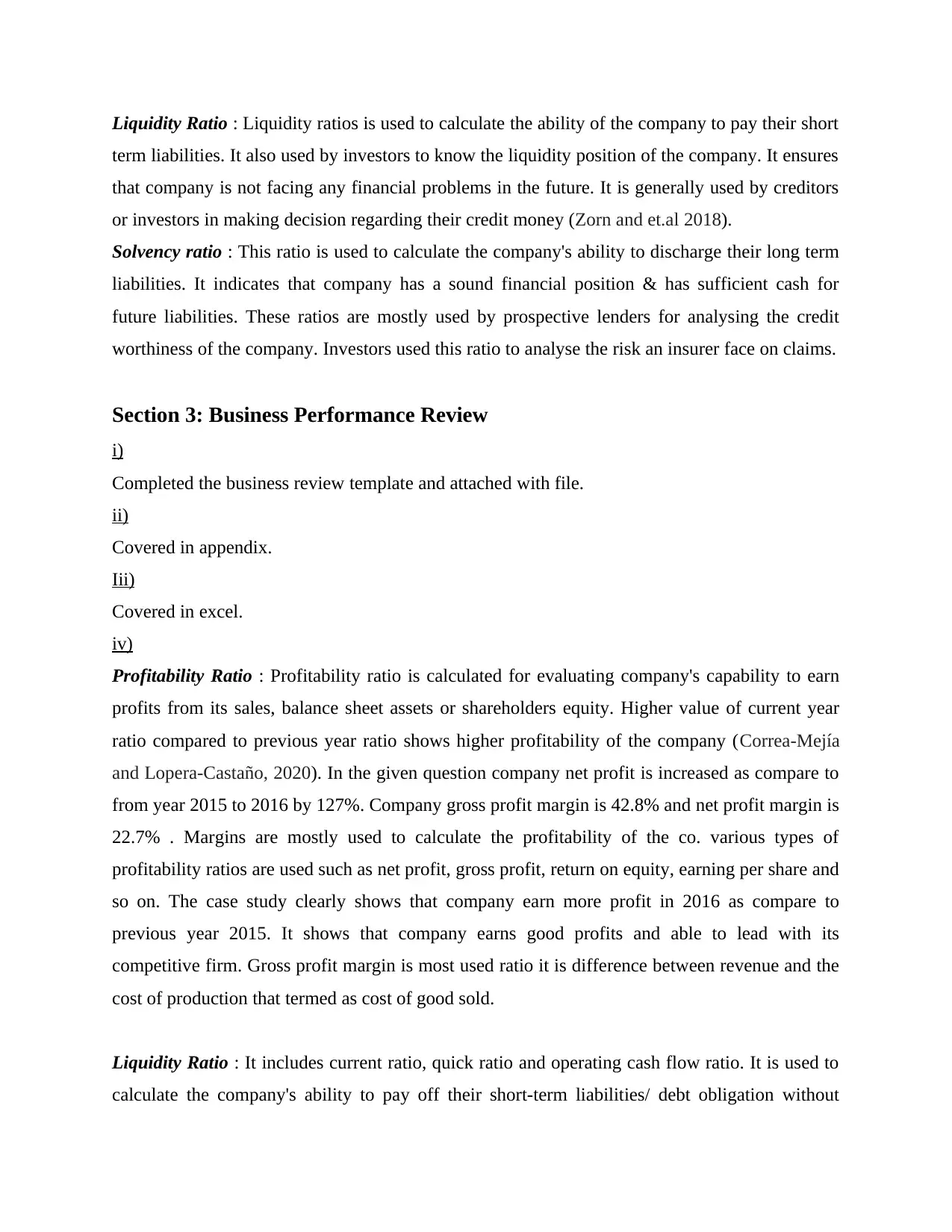
Liquidity Ratio : Liquidity ratios is used to calculate the ability of the company to pay their short
term liabilities. It also used by investors to know the liquidity position of the company. It ensures
that company is not facing any financial problems in the future. It is generally used by creditors
or investors in making decision regarding their credit money (Zorn and et.al 2018).
Solvency ratio : This ratio is used to calculate the company's ability to discharge their long term
liabilities. It indicates that company has a sound financial position & has sufficient cash for
future liabilities. These ratios are mostly used by prospective lenders for analysing the credit
worthiness of the company. Investors used this ratio to analyse the risk an insurer face on claims.
Section 3: Business Performance Review
i)
Completed the business review template and attached with file.
ii)
Covered in appendix.
Iii)
Covered in excel.
iv)
Profitability Ratio : Profitability ratio is calculated for evaluating company's capability to earn
profits from its sales, balance sheet assets or shareholders equity. Higher value of current year
ratio compared to previous year ratio shows higher profitability of the company (Correa-Mejía
and Lopera-Castaño, 2020). In the given question company net profit is increased as compare to
from year 2015 to 2016 by 127%. Company gross profit margin is 42.8% and net profit margin is
22.7% . Margins are mostly used to calculate the profitability of the co. various types of
profitability ratios are used such as net profit, gross profit, return on equity, earning per share and
so on. The case study clearly shows that company earn more profit in 2016 as compare to
previous year 2015. It shows that company earns good profits and able to lead with its
competitive firm. Gross profit margin is most used ratio it is difference between revenue and the
cost of production that termed as cost of good sold.
Liquidity Ratio : It includes current ratio, quick ratio and operating cash flow ratio. It is used to
calculate the company's ability to pay off their short-term liabilities/ debt obligation without
term liabilities. It also used by investors to know the liquidity position of the company. It ensures
that company is not facing any financial problems in the future. It is generally used by creditors
or investors in making decision regarding their credit money (Zorn and et.al 2018).
Solvency ratio : This ratio is used to calculate the company's ability to discharge their long term
liabilities. It indicates that company has a sound financial position & has sufficient cash for
future liabilities. These ratios are mostly used by prospective lenders for analysing the credit
worthiness of the company. Investors used this ratio to analyse the risk an insurer face on claims.
Section 3: Business Performance Review
i)
Completed the business review template and attached with file.
ii)
Covered in appendix.
Iii)
Covered in excel.
iv)
Profitability Ratio : Profitability ratio is calculated for evaluating company's capability to earn
profits from its sales, balance sheet assets or shareholders equity. Higher value of current year
ratio compared to previous year ratio shows higher profitability of the company (Correa-Mejía
and Lopera-Castaño, 2020). In the given question company net profit is increased as compare to
from year 2015 to 2016 by 127%. Company gross profit margin is 42.8% and net profit margin is
22.7% . Margins are mostly used to calculate the profitability of the co. various types of
profitability ratios are used such as net profit, gross profit, return on equity, earning per share and
so on. The case study clearly shows that company earn more profit in 2016 as compare to
previous year 2015. It shows that company earns good profits and able to lead with its
competitive firm. Gross profit margin is most used ratio it is difference between revenue and the
cost of production that termed as cost of good sold.
Liquidity Ratio : It includes current ratio, quick ratio and operating cash flow ratio. It is used to
calculate the company's ability to pay off their short-term liabilities/ debt obligation without
⊘ This is a preview!⊘
Do you want full access?
Subscribe today to unlock all pages.

Trusted by 1+ million students worldwide
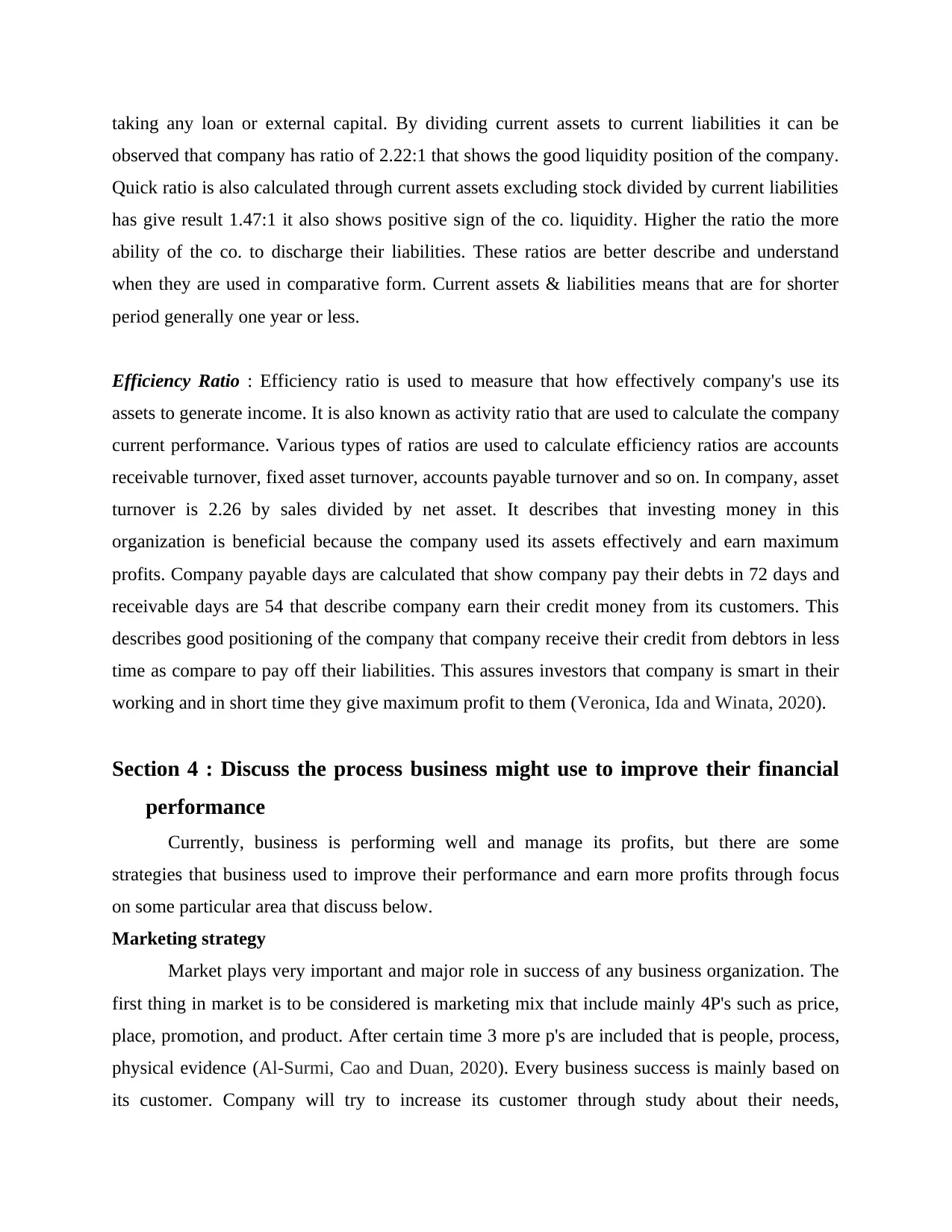
taking any loan or external capital. By dividing current assets to current liabilities it can be
observed that company has ratio of 2.22:1 that shows the good liquidity position of the company.
Quick ratio is also calculated through current assets excluding stock divided by current liabilities
has give result 1.47:1 it also shows positive sign of the co. liquidity. Higher the ratio the more
ability of the co. to discharge their liabilities. These ratios are better describe and understand
when they are used in comparative form. Current assets & liabilities means that are for shorter
period generally one year or less.
Efficiency Ratio : Efficiency ratio is used to measure that how effectively company's use its
assets to generate income. It is also known as activity ratio that are used to calculate the company
current performance. Various types of ratios are used to calculate efficiency ratios are accounts
receivable turnover, fixed asset turnover, accounts payable turnover and so on. In company, asset
turnover is 2.26 by sales divided by net asset. It describes that investing money in this
organization is beneficial because the company used its assets effectively and earn maximum
profits. Company payable days are calculated that show company pay their debts in 72 days and
receivable days are 54 that describe company earn their credit money from its customers. This
describes good positioning of the company that company receive their credit from debtors in less
time as compare to pay off their liabilities. This assures investors that company is smart in their
working and in short time they give maximum profit to them (Veronica, Ida and Winata, 2020).
Section 4 : Discuss the process business might use to improve their financial
performance
Currently, business is performing well and manage its profits, but there are some
strategies that business used to improve their performance and earn more profits through focus
on some particular area that discuss below.
Marketing strategy
Market plays very important and major role in success of any business organization. The
first thing in market is to be considered is marketing mix that include mainly 4P's such as price,
place, promotion, and product. After certain time 3 more p's are included that is people, process,
physical evidence (Al-Surmi, Cao and Duan, 2020). Every business success is mainly based on
its customer. Company will try to increase its customer through study about their needs,
observed that company has ratio of 2.22:1 that shows the good liquidity position of the company.
Quick ratio is also calculated through current assets excluding stock divided by current liabilities
has give result 1.47:1 it also shows positive sign of the co. liquidity. Higher the ratio the more
ability of the co. to discharge their liabilities. These ratios are better describe and understand
when they are used in comparative form. Current assets & liabilities means that are for shorter
period generally one year or less.
Efficiency Ratio : Efficiency ratio is used to measure that how effectively company's use its
assets to generate income. It is also known as activity ratio that are used to calculate the company
current performance. Various types of ratios are used to calculate efficiency ratios are accounts
receivable turnover, fixed asset turnover, accounts payable turnover and so on. In company, asset
turnover is 2.26 by sales divided by net asset. It describes that investing money in this
organization is beneficial because the company used its assets effectively and earn maximum
profits. Company payable days are calculated that show company pay their debts in 72 days and
receivable days are 54 that describe company earn their credit money from its customers. This
describes good positioning of the company that company receive their credit from debtors in less
time as compare to pay off their liabilities. This assures investors that company is smart in their
working and in short time they give maximum profit to them (Veronica, Ida and Winata, 2020).
Section 4 : Discuss the process business might use to improve their financial
performance
Currently, business is performing well and manage its profits, but there are some
strategies that business used to improve their performance and earn more profits through focus
on some particular area that discuss below.
Marketing strategy
Market plays very important and major role in success of any business organization. The
first thing in market is to be considered is marketing mix that include mainly 4P's such as price,
place, promotion, and product. After certain time 3 more p's are included that is people, process,
physical evidence (Al-Surmi, Cao and Duan, 2020). Every business success is mainly based on
its customer. Company will try to increase its customer through study about their needs,
Paraphrase This Document
Need a fresh take? Get an instant paraphrase of this document with our AI Paraphraser
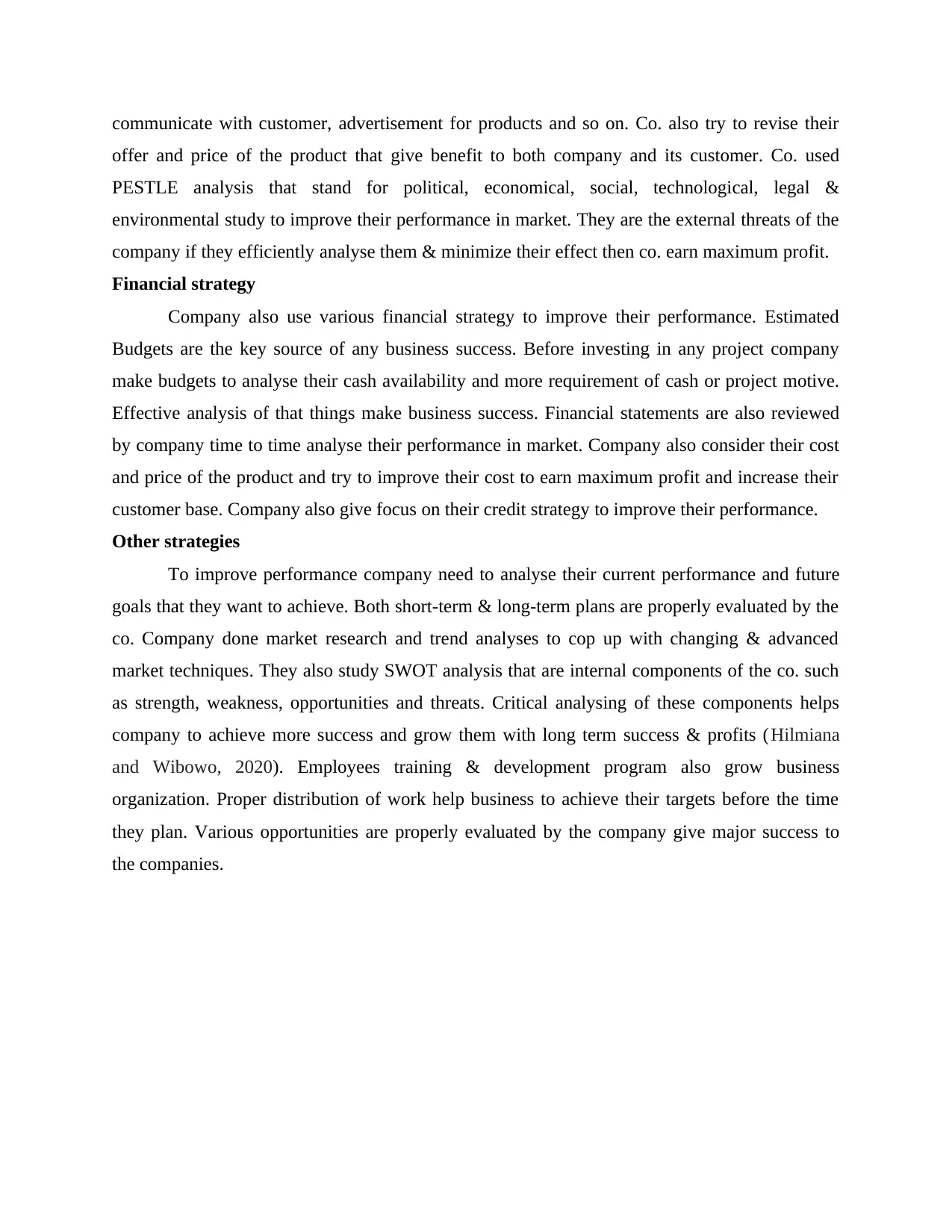
communicate with customer, advertisement for products and so on. Co. also try to revise their
offer and price of the product that give benefit to both company and its customer. Co. used
PESTLE analysis that stand for political, economical, social, technological, legal &
environmental study to improve their performance in market. They are the external threats of the
company if they efficiently analyse them & minimize their effect then co. earn maximum profit.
Financial strategy
Company also use various financial strategy to improve their performance. Estimated
Budgets are the key source of any business success. Before investing in any project company
make budgets to analyse their cash availability and more requirement of cash or project motive.
Effective analysis of that things make business success. Financial statements are also reviewed
by company time to time analyse their performance in market. Company also consider their cost
and price of the product and try to improve their cost to earn maximum profit and increase their
customer base. Company also give focus on their credit strategy to improve their performance.
Other strategies
To improve performance company need to analyse their current performance and future
goals that they want to achieve. Both short-term & long-term plans are properly evaluated by the
co. Company done market research and trend analyses to cop up with changing & advanced
market techniques. They also study SWOT analysis that are internal components of the co. such
as strength, weakness, opportunities and threats. Critical analysing of these components helps
company to achieve more success and grow them with long term success & profits (Hilmiana
and Wibowo, 2020). Employees training & development program also grow business
organization. Proper distribution of work help business to achieve their targets before the time
they plan. Various opportunities are properly evaluated by the company give major success to
the companies.
offer and price of the product that give benefit to both company and its customer. Co. used
PESTLE analysis that stand for political, economical, social, technological, legal &
environmental study to improve their performance in market. They are the external threats of the
company if they efficiently analyse them & minimize their effect then co. earn maximum profit.
Financial strategy
Company also use various financial strategy to improve their performance. Estimated
Budgets are the key source of any business success. Before investing in any project company
make budgets to analyse their cash availability and more requirement of cash or project motive.
Effective analysis of that things make business success. Financial statements are also reviewed
by company time to time analyse their performance in market. Company also consider their cost
and price of the product and try to improve their cost to earn maximum profit and increase their
customer base. Company also give focus on their credit strategy to improve their performance.
Other strategies
To improve performance company need to analyse their current performance and future
goals that they want to achieve. Both short-term & long-term plans are properly evaluated by the
co. Company done market research and trend analyses to cop up with changing & advanced
market techniques. They also study SWOT analysis that are internal components of the co. such
as strength, weakness, opportunities and threats. Critical analysing of these components helps
company to achieve more success and grow them with long term success & profits (Hilmiana
and Wibowo, 2020). Employees training & development program also grow business
organization. Proper distribution of work help business to achieve their targets before the time
they plan. Various opportunities are properly evaluated by the company give major success to
the companies.

⊘ This is a preview!⊘
Do you want full access?
Subscribe today to unlock all pages.

Trusted by 1+ million students worldwide
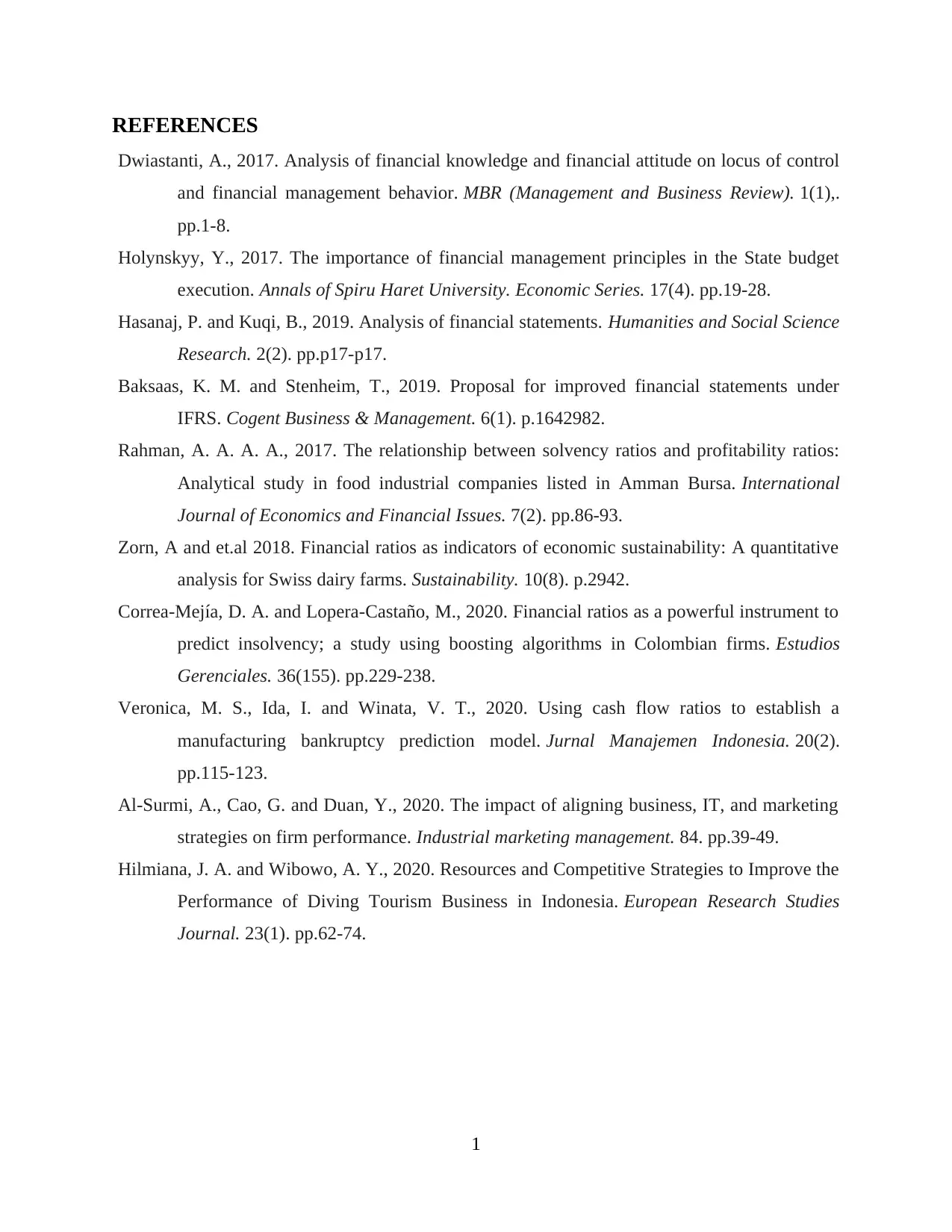
REFERENCES
Dwiastanti, A., 2017. Analysis of financial knowledge and financial attitude on locus of control
and financial management behavior. MBR (Management and Business Review). 1(1),.
pp.1-8.
Holynskyy, Y., 2017. The importance of financial management principles in the State budget
execution. Annals of Spiru Haret University. Economic Series. 17(4). pp.19-28.
Hasanaj, P. and Kuqi, B., 2019. Analysis of financial statements. Humanities and Social Science
Research. 2(2). pp.p17-p17.
Baksaas, K. M. and Stenheim, T., 2019. Proposal for improved financial statements under
IFRS. Cogent Business & Management. 6(1). p.1642982.
Rahman, A. A. A. A., 2017. The relationship between solvency ratios and profitability ratios:
Analytical study in food industrial companies listed in Amman Bursa. International
Journal of Economics and Financial Issues. 7(2). pp.86-93.
Zorn, A and et.al 2018. Financial ratios as indicators of economic sustainability: A quantitative
analysis for Swiss dairy farms. Sustainability. 10(8). p.2942.
Correa-Mejía, D. A. and Lopera-Castaño, M., 2020. Financial ratios as a powerful instrument to
predict insolvency; a study using boosting algorithms in Colombian firms. Estudios
Gerenciales. 36(155). pp.229-238.
Veronica, M. S., Ida, I. and Winata, V. T., 2020. Using cash flow ratios to establish a
manufacturing bankruptcy prediction model. Jurnal Manajemen Indonesia. 20(2).
pp.115-123.
Al-Surmi, A., Cao, G. and Duan, Y., 2020. The impact of aligning business, IT, and marketing
strategies on firm performance. Industrial marketing management. 84. pp.39-49.
Hilmiana, J. A. and Wibowo, A. Y., 2020. Resources and Competitive Strategies to Improve the
Performance of Diving Tourism Business in Indonesia. European Research Studies
Journal. 23(1). pp.62-74.
1
Dwiastanti, A., 2017. Analysis of financial knowledge and financial attitude on locus of control
and financial management behavior. MBR (Management and Business Review). 1(1),.
pp.1-8.
Holynskyy, Y., 2017. The importance of financial management principles in the State budget
execution. Annals of Spiru Haret University. Economic Series. 17(4). pp.19-28.
Hasanaj, P. and Kuqi, B., 2019. Analysis of financial statements. Humanities and Social Science
Research. 2(2). pp.p17-p17.
Baksaas, K. M. and Stenheim, T., 2019. Proposal for improved financial statements under
IFRS. Cogent Business & Management. 6(1). p.1642982.
Rahman, A. A. A. A., 2017. The relationship between solvency ratios and profitability ratios:
Analytical study in food industrial companies listed in Amman Bursa. International
Journal of Economics and Financial Issues. 7(2). pp.86-93.
Zorn, A and et.al 2018. Financial ratios as indicators of economic sustainability: A quantitative
analysis for Swiss dairy farms. Sustainability. 10(8). p.2942.
Correa-Mejía, D. A. and Lopera-Castaño, M., 2020. Financial ratios as a powerful instrument to
predict insolvency; a study using boosting algorithms in Colombian firms. Estudios
Gerenciales. 36(155). pp.229-238.
Veronica, M. S., Ida, I. and Winata, V. T., 2020. Using cash flow ratios to establish a
manufacturing bankruptcy prediction model. Jurnal Manajemen Indonesia. 20(2).
pp.115-123.
Al-Surmi, A., Cao, G. and Duan, Y., 2020. The impact of aligning business, IT, and marketing
strategies on firm performance. Industrial marketing management. 84. pp.39-49.
Hilmiana, J. A. and Wibowo, A. Y., 2020. Resources and Competitive Strategies to Improve the
Performance of Diving Tourism Business in Indonesia. European Research Studies
Journal. 23(1). pp.62-74.
1
Paraphrase This Document
Need a fresh take? Get an instant paraphrase of this document with our AI Paraphraser
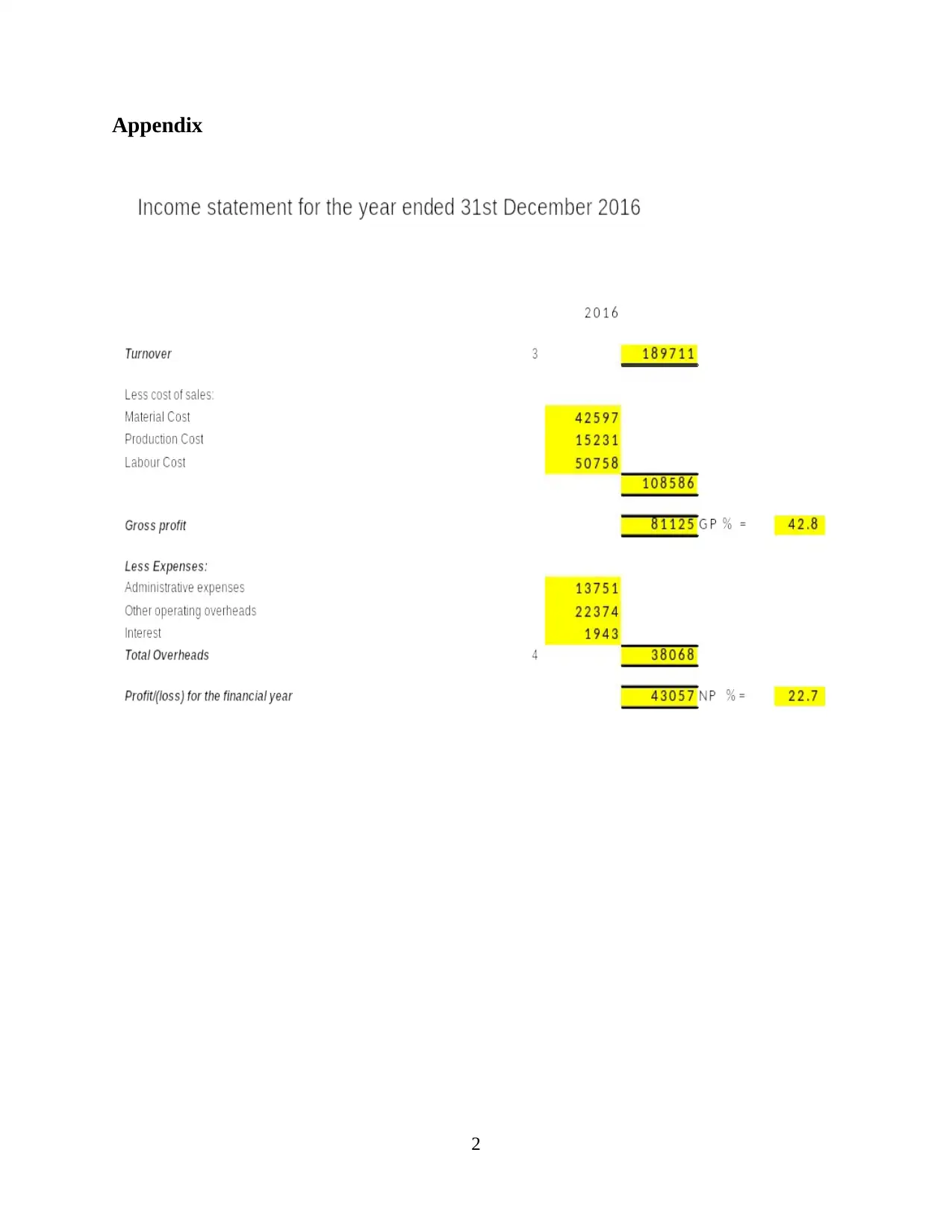
Appendix
2
2
1 out of 11
Related Documents
Your All-in-One AI-Powered Toolkit for Academic Success.
+13062052269
info@desklib.com
Available 24*7 on WhatsApp / Email
![[object Object]](/_next/static/media/star-bottom.7253800d.svg)
Unlock your academic potential
Copyright © 2020–2025 A2Z Services. All Rights Reserved. Developed and managed by ZUCOL.




